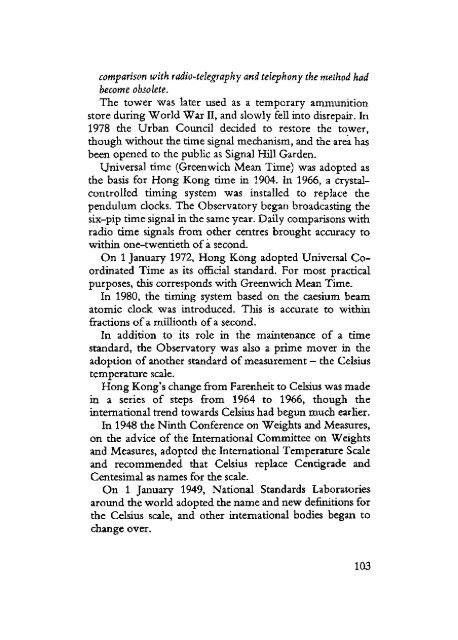Royal - HKU Libraries - The University of Hong Kong
Royal - HKU Libraries - The University of Hong Kong
Royal - HKU Libraries - The University of Hong Kong
You also want an ePaper? Increase the reach of your titles
YUMPU automatically turns print PDFs into web optimized ePapers that Google loves.
comparison with radio-telegraphy and telephony the method hadbecome obsolete.<strong>The</strong> tower was later used as a temporary ammunitionstore during World War II, and slowly fell into disrepair. In1978 the Urban Council decided to restore the tower,though without the time signal mechanism, and the area hasbeen opened to the public as Signal Hill Garden.Universal time (Greenwich Mean Time) was adopted asthe basis for <strong>Hong</strong> <strong>Kong</strong> time in 1904. In 1966, a crystalcontrolledtiming system was installed to replace thependulum clocks. <strong>The</strong> Observatory began broadcasting thesix-pip time signal in the same year. Daily comparisons withradio time signals from other centres brought accuracy towithin one-twentieth <strong>of</strong> a second.On 1 January 1972, <strong>Hong</strong> <strong>Kong</strong> adopted Universal CoordinatedTime as its <strong>of</strong>ficial standard. For most practicalpurposes, this corresponds with Greenwich Mean Time.In 1980, the timing system based on the caesium beamatomic clock was introduced. This is accurate to withinfractions <strong>of</strong> a millionth <strong>of</strong> a second.In addition to its role in the maintenance <strong>of</strong> a timestandard, the Observatory was also a prime mover in theadoption <strong>of</strong> another standard <strong>of</strong> measurement — the Celsiustemperature scale.<strong>Hong</strong> <strong>Kong</strong>'s change from Farenheit to Celsius was madein a series <strong>of</strong> steps from 1964 to 1966, though theinternational trend towards Celsius had begun much earlier.In 1948 the Ninth Conference on Weights and Measures,on the advice <strong>of</strong> the International Committee on Weightsand Measures, adopted the International Temperature Scaleand recommended that Celsius replace Centigrade andCentesimal as names for the scale.On 1 January 1949, National Standards Laboratoriesaround the world adopted the name and new definitions forthe Celsius scale, and other international bodies began tochange over.103
















